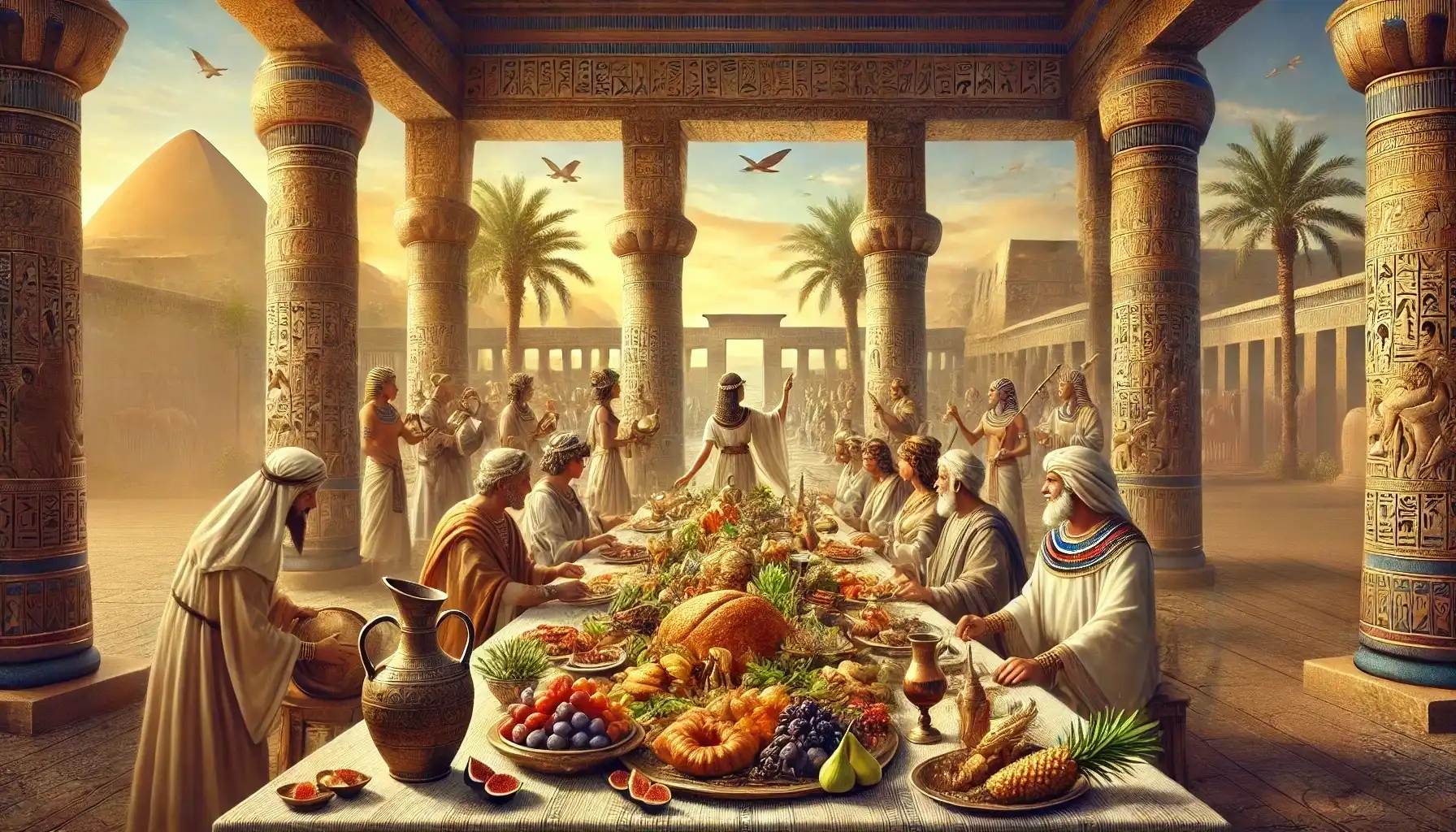The Breadbasket of the Nile: Staple Foods of Ancient Egypt
The ancient Egyptians were masters of harnessing the fertile gifts of the Nile. Their diet, deeply rooted in the rhythms of the river, was built on a foundation of grains, fruits, and vegetables that sustained a civilization for millennia.
Grains: The Staff of Life
At the heart of their cuisine was bread, made from emmer wheat and barley. These grains were ground into flour using stone querns, a labor-intensive process that often left tiny grit fragments in the bread, leading to worn teeth found in skeletal remains. Bread was not just sustenance; it was a symbol of life itself, often placed in tombs to nourish the deceased in the afterlife.
The Egyptians baked a variety of breads—flatbreads, leavened loaves, and even sweetened versions with honey or dates. Archaeologists have uncovered ovens and baking molds, revealing the sophistication of their culinary techniques.
Fruits and Vegetables: A Colorful Palette
The Nile’s fertile banks yielded an abundance of produce. Onions, garlic, leeks, and lettuce were staples, often eaten raw or cooked. Lentils, chickpeas, and beans provided protein, while fruits like dates, figs, grapes, and pomegranates added sweetness to their diet.
The humble date, in particular, was a versatile ingredient. It was eaten fresh, dried, or pressed into syrup. Its sweetness made it a natural preservative, and it was often used to flavor breads and brews.
Feasts of the Gods: Culinary Traditions and Rituals
Food in ancient Egypt was more than mere nourishment; it was a bridge between the earthly and the divine. The gods themselves were believed to partake in the offerings laid before them, and feasting was a sacred act.
Offerings to the Divine
Temples were centers of culinary activity, where priests prepared elaborate meals for the gods. These offerings included bread, beer, roasted meats, and fruits, symbolizing the bounty of the land. After the gods had their fill, the food was distributed to the temple staff and the poor, ensuring that nothing went to waste.
Festivals and Feasts
Public festivals were occasions for communal feasting. During the Opet Festival, celebrated in Thebes, the streets were filled with the aroma of roasted meats and the sound of laughter. Beer, a staple of Egyptian life, flowed freely, brewed from barley and flavored with dates or herbs.
The Flavors of the Nile: A Culinary Journey
The ancient Egyptian palate was rich and varied, shaped by the land’s natural bounty and the ingenuity of its people.
Meat and Fish: From the River and Beyond
While the common people relied heavily on plant-based foods, meat was a luxury reserved for the elite and special occasions. Beef, pork, and goat were consumed, often roasted or stewed. Wild game, such as gazelle and waterfowl, added variety to the diet.
Fish from the Nile—tilapia, catfish, and perch—were a vital protein source. They were eaten fresh, dried, or salted, and their importance is reflected in tomb paintings and hieroglyphs.
Spices and Flavors
The Egyptians had a keen appreciation for flavor. Coriander, cumin, and dill were commonly used, as were garlic and onions. Honey was the primary sweetener, while salt, harvested from the Mediterranean, preserved and seasoned their food.
A Legacy Carved in Stone
The culinary traditions of ancient Egypt have left an indelible mark on history. From the humble loaf of bread to the lavish temple feasts, food was a reflection of their culture, spirituality, and connection to the land.
Today, we can still glimpse their world through the remnants of their meals—charred grains in ancient ovens, dried fruits in tombs, and the timeless recipes etched on temple walls. Their diet was not just a means of survival but a celebration of life itself, a testament to the enduring power of the Nile’s bounty.
Conclusion: A Taste of Eternity
The food of ancient Egypt offers a window into a civilization that thrived for thousands of years. It was a diet shaped by the rhythms of the river, the demands of the gods, and the ingenuity of its people. From the simplest loaf of bread to the most elaborate feast, their cuisine was a reflection of their world—a world that continues to captivate and inspire us today.
As we explore their culinary legacy, we are reminded that food is more than sustenance; it is a story, a ritual, a connection to the past. And in the case of ancient Egypt, it is a story that has endured, carved in stone and etched in memory, for eternity.
The Role of Beer in Ancient Egyptian Society
Beer was a cornerstone of ancient Egyptian life, consumed by people of all ages and social classes. It was not just a beverage but a dietary staple, providing essential nutrients and calories.
Brewing Techniques
The brewing process began with barley bread, which was partially baked to leave the yeast active. The bread was then crumbled into water and left to ferment in large vats. The resulting mixture was strained to remove solids, producing a thick, nutritious drink.
Cultural Significance
Beer was often used as wages for laborers, including those who built the pyramids. It was also a key component of religious offerings, symbolizing the life-giving properties of the Nile.
The Influence of Trade on Egyptian Cuisine
Ancient Egypt’s strategic location made it a hub for trade, bringing exotic ingredients and culinary techniques from distant lands.
Spices and Herbs
Trade with the Near East introduced spices like cinnamon and black pepper, which were highly prized and used sparingly. Herbs such as thyme and mint added depth to their dishes.
Exotic Fruits and Nuts
The Egyptians imported fruits like apricots and peaches from Persia, as well as nuts like almonds and pistachios. These ingredients were often reserved for the elite and used in special dishes.
The Evolution of Egyptian Cuisine Over Time
The diet of ancient Egypt evolved over millennia, influenced by changes in climate, technology, and foreign interactions.
Early Dynastic Period
During the Early Dynastic Period, the diet was relatively simple, focusing on grains, vegetables, and fish. Meat was a rare luxury, consumed only during festivals and religious ceremonies.
New Kingdom Era
By the New Kingdom, Egypt’s empire had expanded, bringing wealth and new culinary influences. The elite enjoyed a more varied diet, including imported wines, exotic fruits, and elaborate meat dishes.
The Legacy of Ancient Egyptian Cuisine
The culinary traditions of ancient Egypt have left a lasting impact on the world. Many of their staple foods, such as bread and beer, remain central to diets across the globe.
Modern Adaptations
Today, chefs and food historians are rediscovering ancient Egyptian recipes, adapting them for contemporary palates. Dishes like ful medames, a fava bean stew, trace their origins back to the Nile Valley.
Cultural Heritage
The food of ancient Egypt is a testament to the ingenuity and resilience of its people. It reflects their deep connection to the land, their reverence for the divine, and their ability to create a rich and varied cuisine from the simplest ingredients.



